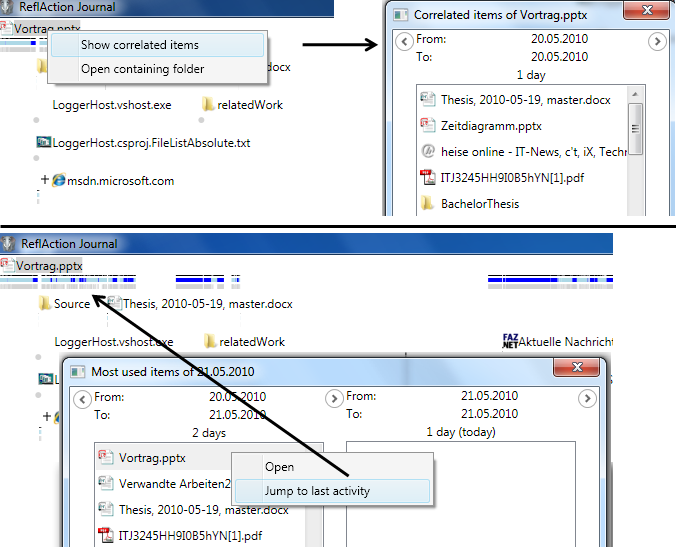The paper Improving Re-Finding upon Work Resumption has been accepted for presentation at the SIGIR 2010 Workshop on Desktop Search. It shows the combined use of three ReflAction tool-suite components, which all rely on the personal-experience-trace metadata provided by the ContextDrive system.
Improving Re-Finding upon Resumption of Computer-Work
The paper presents an approach to reducing user efforts when reorienting to interrupted work. This features a time-centric Journal view of a user’s information-work activities, which allows going back to ‘task states’ for activity resumption. We further compute an activity-induced correlation function to reflect information coherence, as emerging and developing on the user’s side when ‘using information items together’. We thereby investigate the expressiveness of easy to understand correlation indicators, such as temporal proximity, window switching, and clipboard use. Finally, we present a list of most-used items, which is considered to provide suitable ‘entry points’ for work resumption.
ReflAction Journal
One approach for determining the information items needed to continue an interrupted activity, is re-finding those items, which have been the object/s of a user’s activities by the time when the interruption occurred (activity-phase specific approach). The ReflAction Journal supports this approach by presenting so-called activity objects to the user.
The ReflAction-Journal visualization is based on computer-observable fractions of information work. In the figure below, the doing pane shows item-related user activities (uA), which mirror that a user’s activities leave traces on those items. Accordingly, an activity object is composed of an information item (defining its name), and the traces related to the item, where the latter are sets of {focus, edit/view, visibility} intervals, representing, if so, interrupted item-related user activities.
The re-finding means enabled by the ReflAction Journal improve today’s common user experience that computers do not well support the “leaving the task (state) as it is” strategy, as they are not hampered by closed windows.
ReflAction Correlated & MostUsed
Imagine that a few days have passed since a user had extensively used some important information sources of a presentation (or any other) document. Even though she meanwhile proceeded with editing the presentation, she still perceives those sources as related to her presentation document a. Therefore, we provide a function called uA-related, which is used to determine correlated items within a time frame (across activity phases). Its user interface (upper part of the below figure) is an early prototype and doesn’t allow convenient control over time scoping yet.
The intuition behind the uA-related function is that information items ‘used together’ implicitly gain activity-induced coherence. Let uA-related(a, b) denote the function mapping the tuple (a, b) to the correlation strength of b to a. The construction of this function is illustrated in the paper. It is called for all b’s within the provided time frame. So, uA-related(Vortrag) for ‘today’ yields the list of items presented in the figure above.
The most-used list shown in the lower part of the figure above provides the main working documents to a user, which are considered suitable ‘entry points’ to resuming one’s work. Each entry of the most-used list is computed by evaluating the aggregated lengths of activity intervals per item within a time frame, where, in general, editing has more weight than viewing.
Open-Source Sister Projects
Together with Federico Mena’s journal prototype and mayanna, the ReflAction Journal and the ContextDrive system have been influential forerunners and, by now, are sister projects of the (GNOME) Activity Journal (GAJ) and Zeitgeist. As of today, the latter is one of less than 30 featured projects on launchpad (of approx. 19000 hosted projects) and was recently announced to be a key technology embraced by Unity.
The function behind the ReflAction correlatedItems-list is similar in aim to the experimental ‘findRelatedUris’ Zeitgeist-function by Seif Lotfy. Analogous for the function behind the ReflAction mostUsed-items list and the Zeitgeist-API function ‘findEvents((begin,end),…, mostPopularSubjects,…)’. For more on this, see the Zeitgeist DBus-API documentation and my earlier posts on ‘implicit relating’ (1,2) and ‘personal semantic technology‘.
The Zeitgeist and Elementary teams are currently hacking on Sezen. It is the first user interface built on top of Zeitgeist, which has the new Zeitgeist ‘full-text search’ extension, provided by Mikkel Kamstrup and Canonical. Big thanks for providing this awesome extension!! … GAJ will get it too ![]() … So stay tuned!
… So stay tuned!

